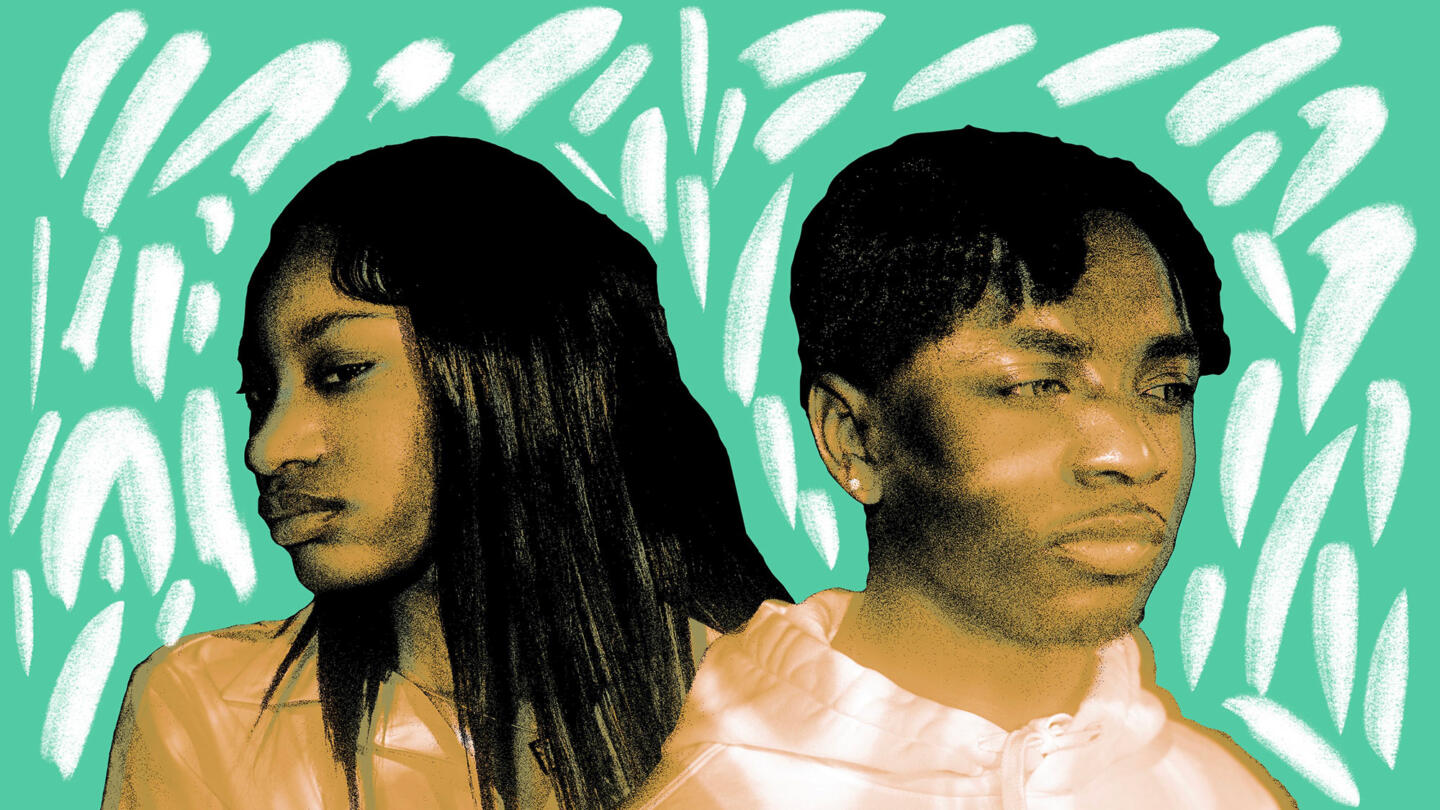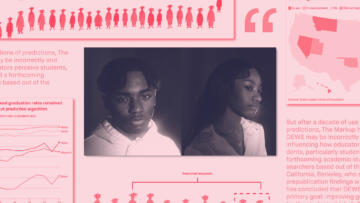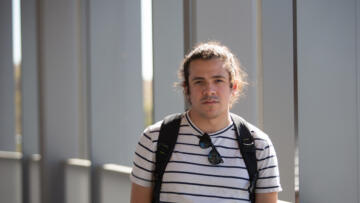During the second half of our junior year of high school, we were shocked to learn about an algorithm called the Dropout Early Warning System (DEWS) that our home state of Wisconsin had been using to predict future dropouts. As Black students, who make up nine percent of the public school student body statewide, it felt wrong that factors like the color of our skin contributed to whether we’d be labeled as “high risk” of dropping out—especially because the algorithm is often wrong.
Twice a year, Wisconsin public schools receive a list of their enrolled students with the DEWS color-coded prediction next to each name: green for low risk, yellow for moderate risk, or red for high risk of dropping out. These predictions were based on factors like test scores, attendance, disciplinary history, and free or reduced-price lunch status. DEWS predictions were wrong nearly three-quarters of the time, and it was wrong at significantly greater rates for Black and Hispanic students than it was for White students.
We only learned about DEWS because Todd Feathers, a reporter from The Markup, reached out to us. Earlier this year, we told him about founding our school’s first Black Student Union in response to racist incidents we’d experienced, and why labels from an automated algorithm stung.
After we shared our stories as a part of the investigation, we saw that the Wisconsin Department of Public Instruction (DPI) removed DEWS data from school dashboards in October. This means that after 10 years of calculating DEWS scores, the state is considering changes to the DEWS algorithm. As DPI evaluates what comes next, we knew there was more to share in our own words about our experiences navigating the public school system while Black.
(Responses from Mia and Maurice have been edited lightly for brevity and clarity.)
The shock of learning about DEWS
Mia Townsend: When Todd first reached out, he broke down the statistics of the DEWS algorithm. I was initially thrown for a loop that an algorithm using race to predict our future was even a thing. I felt as if—instead of using these algorithms to label kids as “high risk” or make people feel less than, or that they have the short end of the stick in life—they should be using this to figure out ways to improve the environment in “higher-risk” areas, like the schools I used to attend on the north side of Milwaukee. It made me wonder if all schools are aware of these statistics and whether they’re worried about the future.
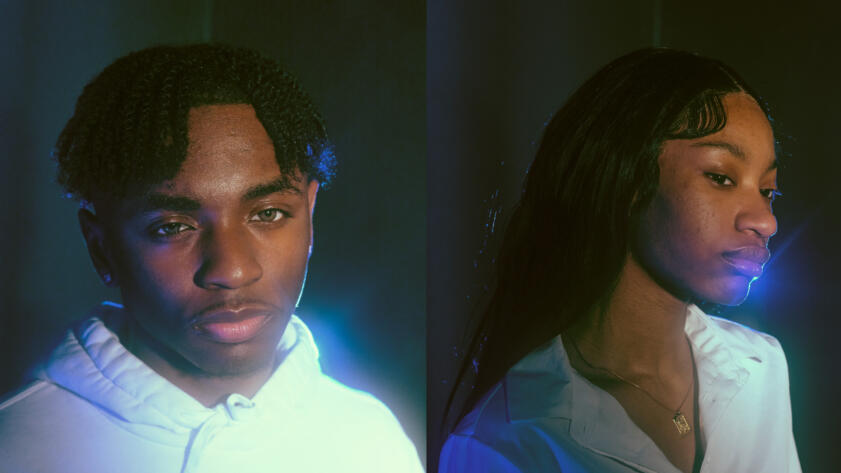
Machine Learning
False Alarm: How Wisconsin Uses Race and Income to Label Students “High Risk”
The Markup found the state’s decade-old dropout prediction algorithms don’t work and may be negatively influencing how educators perceive students of color
I was excited to share my story with The Markup; how many juniors in high school can say they’re being featured in news articles? What kid my age is doing photo shoots and talking about their experiences creating and growing clubs within their school? This article also opened my eyes and doors for more conversations about racism within school systems. Maurice and I continued these conversations within a “restorative practice” group that emerged at the beginning of this school year. With teacher support, students collaborate to advocate for the school to enact better mental health policies and reach out within our community to students who need help. This group helped so many people reckon with the racism, anti-gay bias, anti-immigrant discrimination, ableism, and sexism that students face on campus.
Maurice Newton: When Todd told us about DEWS, I was shocked to hear that the state uses race as a method to predict likelihood of graduating. I believe it is wrong for them to try to predict anything—and it turns out the algorithm’s predictions are wrong every year. Instead of predicting failure, our school system should be trying to assist the students who need actual help, whether they need a home or lifesaving resources. Test scores and behavior are not always a factor in why students drop out of high school.
The fact that White students aren’t considered “high risk” nearly as often is concerning because the same factors affect African Americans and Hispanic students face as any other race. The use of the words “high risk” not only targets students of color, but it doesn’t motivate them to graduate. That label is also unmotivating to those students who are struggling.
When the story was finally published, Mia and I were very proud of ourselves for sharing our story. We posted it on social media—and, just like us, a lot of students were surprised that this was occurring in our state. Being photographed for the story gave readers real-life examples of how Mia and I succeeded in high school while holding jobs. We as African American students in Wisconsin proved the algorithm wrong. We are living the true life and not a “predicted” life.
How we navigate Wisconsin public schools as Black students
Mia: I have changed schools pretty frequently, and some of them were due to not-so-healthy environments. Schools more southwest of Wisconsin offered more opportunities and higher academic tools but were majority-White, and there wouldn’t have been any issues with that if the staff had appropriately dealt with their racial issues.
At age 12, I felt that ignoring these racial issues would help me get through the year; instead, it made the school year unbearable. During this time I began having panic attacks triggered by constant bullying and feeling as if I had no one to turn to. My parents constantly visited the school, and they became fed up that no actions were being taken and removed me. Moving to a school on the north side of Milwaukee, the environment was majority-Black, but there was no structure; there were people fighting every day, families invading the schools with guns and knives, and kids not staying seated long enough to learn.
Despite the unstructured environment of that school, I felt more connected with the students and teachers there. They give their students more chances, which may have contributed to the unstructured environment, but we always knew the teachers cared. I don’t remember a thing I learned that school year, but I will tell you I made the most memorable relationships with the people there.
The school I currently attend, Cudahy High School, is in a suburb of Milwaukee and has a lot of opportunities and ways to further their students’ education and growth even after graduation. They offer programs that help you get a nursing assistant certification, earn early college credit, and seminars preparing students for college. Despite these opportunities, all schools have their pitfalls. My first year of high school was virtual due to COVID, and this put a lot of kids’ motivation on a decline. Even after school resumed, the environment I once encountered in my past seemed to follow. I would still witness racist remarks and jokes that would often trigger uncomfortable memories I once experienced.
At Cudahy High School, Black students have felt recurring racial issues within the school system were being swept under the rug. But the only time we see disciplinary measures taken is when students take things into their own hands with violence or come to the Black Student Union members and address the incident. We kids don’t feel comfortable initially bringing up these incidents with administrators, so we have made the BSU a safe space for all people to share their experiences, but it shouldn’t be our job to address and correct other students’ bad behavior.
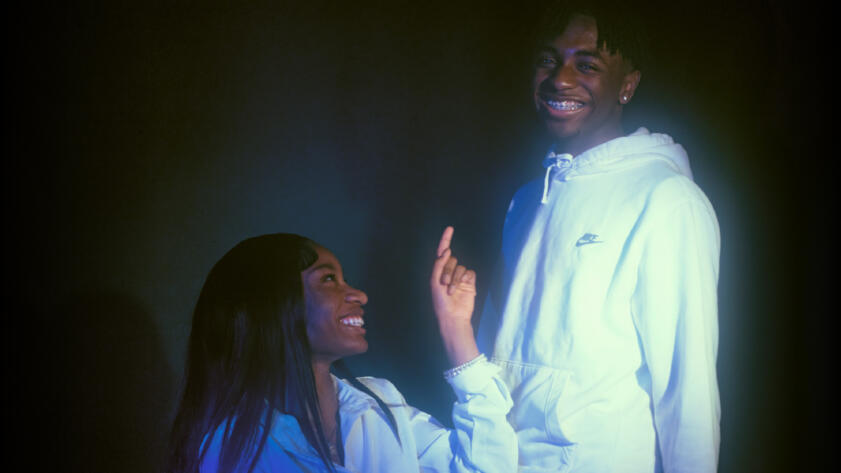
Hello World
Stitching Your Own Safety Net
Black kids in Wisconsin are supporting each other in ways the state hoped an algorithm would
An issue was brought to our attention concerning some racially motivated “jokes.” A group of White students had approached a Black student and threw a handful of bananas on their lunch tray. The White students continued mocking the Black student while making monkey noises. This issue was dealt with right then and there by one of our administrators, whose support has never faltered. But looking back, I realize these issues were handled first by the students at the center and handed over to the administration to enforce disciplinary decisions.
Sometimes the ill remarks come from the teachers, who should know not to make comments such as “Do you speak English?” to a new student moving from Africa, or “Me and my wife say Nutter Butters are hood/ghetto snacks” to a Black student eating in class. These are things I have witnessed firsthand as ignorant comments that contribute to the reluctance people of color have with seeking out help within the school system.
Issues like these are the reason students have built the courage to create family-like communities such as the BSU, where we’ve established a place to feel safe and understood.
Maurice: I grew up on the north side of Milwaukee, but moved over to Cudahy schools in 2015.
As the oldest of three kids, I take on great responsibility. I currently work three jobs and attend high school while earning college credits at the same time. I started working at 14, and over the years I’ve worked at different fast-food establishments and held three management positions. I matured at a young age to prepare myself for adulthood. With my knowledge and skills, I could help others. I always reflect on where I started because I would have never thought I would have the courage to become a young person in management.
Test scores and behavior are not always a factor in why students drop out of high school.
I have seen a lot of young Black men turn to the streets because they don’t have a mentor to help them become successful and grow into an adult. I believe my mother did an amazing job raising me by herself so that I didn’t turn to the streets. This school year, I am currently the Black Student Union president, the National Honor Society secretary, the student representative on the Cudahy School District’s Board of Education, the school store manager, the treasurer of Distributive Education Clubs of America, a lead student mentor, and lead facilitator with the school’s restorative practice group.
So many bad things have happened over the years to African American people: police brutality, racism, killing, and hate. I’ve been lucky enough to have a strong mother who was able to keep me away from those situations. She has done a phenomenal job at raising me and my siblings and keeping us where we need to be.
Anytime I meet Black students, I always try to prepare them for life, especially African-American boys who do not have a role model; I try to fill in when I can. Being Black isn’t easy. Our lives are at risk every day, and the only thing I can do is educate young African Americans how to live in this world. My mother worries a lot because of all the bad things happening, so she instilled in me everything I needed to know about living in a cruel world.
Founding our school’s first Black Student Union
Maurice: I considered Cudahy a predominantly White school—but over the years, the number of different races has increased significantly. In my first two years attending Cudahy, it was a struggle to get to know other students. I would mostly see White students, and I didn’t connect with some of my classmates. In 2020, our schools shut down due to COVID-19, which caused a change in the atmosphere. Some students were isolated at home, away from their peers. When school allowed us to come back, I had an especially hard time connecting with others because of that loss of social time.

Hello World
Dropout Risk System Under Scrutiny After The Markup Report
The Center for Democracy & Technology makes a case for civil rights protections
During the 2021–2022 school year (my sophomore year), four seniors created a Black Student Union for the small African American population in the school; with the dedication of one of our former beloved math teachers, Mrs. Kerry Beamon, who passed away, the group was approved by administration and started later that year. Some of the seniors who started the group encouraged me to join. At the end of the year, we gained more members, and I was appointed president for the following school year. It was my strong sense of leadership and dedication to the group that made me stand out.
My junior year, the first year running the BSU, we were able to grow from 12 members to over 50 members. I believe we made this happen so we could connect with more people and build connections with others.
The mission of the BSU is to promote inclusion, encourage student voices, and strengthen staffers’ and students’ understanding of Black history and culture. During the year, we taught many people about Black history and built people into strong leaders. Our group was open to all students; we thought it was important for everyone to learn Black history.
Mia: Maurice and I were close friends with the people forming the group and followed close behind as we were interested in joining and maybe even leading in some of the group activities in the future. A teacher we had progressively grown more comfortable around (Ms. Youngvorst) quickly took on the adviser role. She is someone all of us came to with our issues, and it only felt right for her to fulfill that role. Alongside her is our beloved adviser Mrs. Kerry Beamon, who felt like a mother to us. Unfortunately, we lost Mrs. Beamon to colon cancer last year, but we continue to honor her in our work.
‘Our work is finally being recognized’
Mia: The BSU has collaborated with University of Wisconsin, Parkside, taken a trip to America’s Black Holocaust Museum, hosted a movie night for friends and family, visited our local elementary school with activities during Black History Month, made shirts, raised money for colon cancer in Mrs. Beamon’s honor, and hosted our annual Thanksgiving feast. I believe our work is finally being recognized now that faculty members have begun to see that students are holding people accountable for their actions, doing community outreach, and educating each other on our concerns about life outside of the classroom.
The great thing about the community we’ve made is how we all encourage each other. As I was already taking honors classes, I understood the workload that came with being in an advanced class. However, with the numerous clubs and activities I was involved in, I didn’t know if I could take on any more responsibilities. The 2022–2023 school year was a very difficult time for me, and my grades fluctuated constantly. I knew I could achieve good grades, as I have made the high honor roll numerous times. My counselor, however, felt that since I was struggling in my past courses, she wouldn’t recommend me going for AP.
But then Maurice and I discussed our future classes, and I mentioned how I was hesitant about taking AP classes. If I felt I could handle the classes, he said, I should go for it. His encouragement, as well as that of my parents, led me to apply for AP Literature as well as AP Psychology— a class I’ve been interested in for a while.
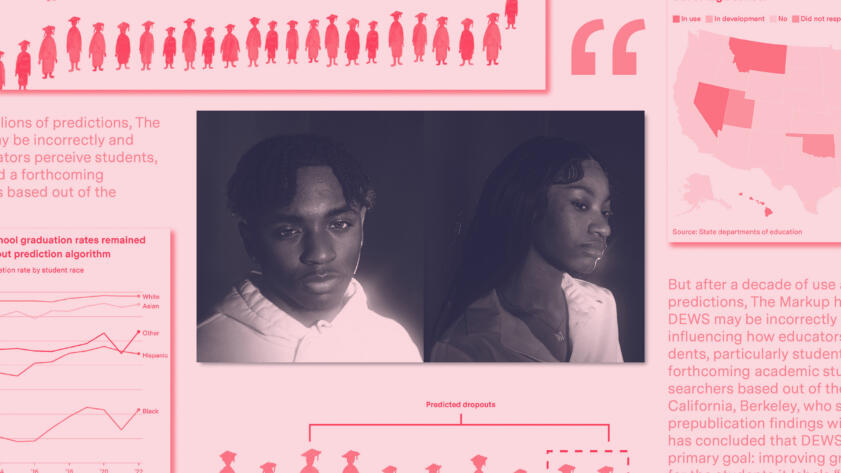
The BreakdownMachine Learning
Takeaways from Our Investigation into Wisconsin’s Racially Inequitable Dropout Algorithm
Wisconsin’s Dropout Early Warning System (DEWS) scores every middle schooler based on income, race, and more
I’m enjoying these courses and the challenges they bring. Something I was once afraid to even consider is now the thing I look forward to the most. If I’d never taken that leap of faith and tried something new, I wouldn’t have known how welcoming and patient the teachers are about learning in these classes. The teaching style used during psychology is very experimental, hands-on, and uses a lot of in-class discussions to test psych theories. During AP Literature, students are constantly reading novels, creating projects, and researching real-world events .
Maurice: When creating the BSU, we did receive pushback from some Cudahy students and community members, but the school staff was wonderful and supportive. We sold BSU T-shirts to the whole district, raised money for the group, and even received donations. This year, even more students joined, and now we are at about 63 members. I again was elected president for a second term as a senior, and this year my goal is to develop more students into becoming leaders and help them through their journey in high school and beyond.
Everywhere you go, there is always going to be one person who has racist intentions and says bad things to you. In our school, we’ve had incidents where we as the BSU would discuss issues and work with the administration to find solutions. I felt like since our administration team is predominantly White they wouldn’t understand how it feels to be called a derogatory word, for example. They understand that it’s wrong, but how they handle it is different from how the BSU handles it. When situations come up, we bring them to the whole group and discuss. As one of the first members of our school’s restorative practice group, I helped bring the practice to the BSU, and that’s how we discuss these situations. Getting input from our peers helps us deal with situations.
Something I was once afraid to even consider is now the thing I look forward to the most.
Within BSU, my executive team and I make it a goal to try to help our members with classes and life outside of school. A goal of mine was to help Mia, last year’s vice president, to get into AP classes for her senior year. Mia is a very intelligent young woman who has the potential to succeed in an AP class. I was very determined to get her into these classes so she could push herself. When talking with Mia, she said she was nervous and afraid of AP because of how it is discussed. I previously took AP classes and was able to give advice and provide information on how the classes run. I feel like some teachers encourage students to take AP, but the encouragement coming from your own classmates makes it better. This year I’m currently taking AP Literature & Composition, AP Calculus AB, and AP Psychology. I get to take courses at the Milwaukee School of Engineering to get an early start on furthering my education. I also got the opportunity to leave school during the day for work.
I usually spend most of my time at school working with other students. I am very proud of myself for spending my time helping. I think it’s important to have a mentor, as I didn’t have one during my first and second years of high school. It was especially tough not having that connection with any juniors and seniors during the pandemic. I struggled a lot with transitioning back into attending classes physically on campus after being virtual.
As first- and second-year students continue through the year, I always check in with them to let them know that they can also have these opportunities as a senior if they stay focused on their grades and credits. I never have a problem with helping out.
